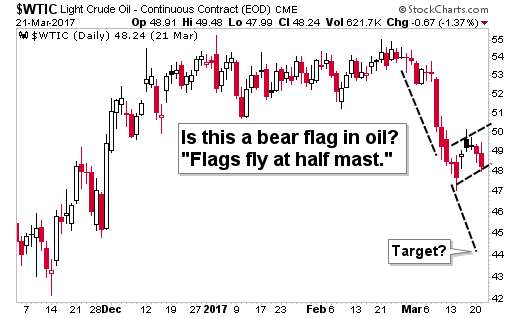The market has been cruising along for so long that many investors forget bad things can happen. Boy, they can happen. And before they do, you need to buy ONE THING.
See, the market is like a big, beefy guy out mowing his lawn on a weekend morning. He carries a lot of weight, but he needs that weight to throw around. He always gets his way.
And the lawn. Well, the wife has been crabbing at him to mow that lawn all week. He has to get it out of the way before the games start in the afternoon, right? So he is striding across that lawn, chopped grass flying around like money confetti, and nothing is going to stop him.
Until something does.
It starts as a twitch in his arm. Then a pain spreads down his arm into his chest. Damn, must have pulled something, right? Probably tugging on that lawnmower too much in the turns.
So the big guy slows down. But the pain doesn’t. It gets stronger. And then there’s tightness all across his chest, and up into his jaw. For Pete’s sake, what’s that about? Then he realizes his breath is coming short and fast. He can’t seem to fill his lungs to save his life.
And by the time he falls to his knees, he can only pray his wife sees what’s going on and calls the paramedics before it’s too late.
That’s just what happened, metaphorically speaking, to the stock market in 2000. Stocks dropped by 50%.
It happened again in 2007-’09. It was worse that time, like all second heart attacks are. That time, the S&P dropped by 57%.
Guess what went up both times? I’ll give you a golden minute to think about it. Then look at this chart of the action in the S&P 500 from 2000 to 2002.
The bad news started in August. I remember that, by February, you could see the signs of worry on faces all over Wall Street.
Except the gold traders. In February, they started to smile. And that smile spread wider for gold … even as the S&P 500 went down for the count.
I could show you a chart of 2007, but you get the picture.
Fast-forward to today. Let’s talk about the weight the market is carrying around. That big lug, he’s only piled on more pounds.
You want to talk debt? The national debt was recently $165,542 per taxpayer. My, that is on the portly side.
You want to talk household net worth to GDP? That’s a metric that the boys at Sprott are using in a new commentary. Analyst Trey Reik says this measure is WA-A-AY out of whack. And if it adjusts down to a reasonable level, Trey writes, it implies:
"A decline of between $36 trillion and $46 trillion in the aggregate value of the three major U.S. asset classes (stocks, bonds and real estate)."Wait … $46 trillion? Now we’re talking real money.
But hey, let’s keep it simple. Let’s talk good ol’ fashioned P/E multiples. The S&P 500 is at 24.5. That’s a lot, especially considering lackluster earnings growth and an economy stuck in second gear.
Yeah, the P/E ratio has been higher before. During the financial crisis, and twice during the dot-com boom and bust.
Do you remember what happened to markets during those times?
I sure do. I still have the scars.
But gold, now, gold is a safe haven when the market has a heart attack. Or gets run over by a lawnmower. Use whatever metaphor you want. But you know that there will be another crisis.
When the market clutches its chest and keels over, you’ll want a layer of gold to armor your wealth. Buy it now while it’s cheap.
You know that heart attack is coming. Be ready.
All the best,
Sean Brodrick
P.S. Record-high margin debt is just another example of the market carrying too much "weight." Here’s what that may mean for stocks
If you liked or hated this article, please comment on the original post at https://www.uncommonwisdomdaily.com/next-heart-attack-24114

























